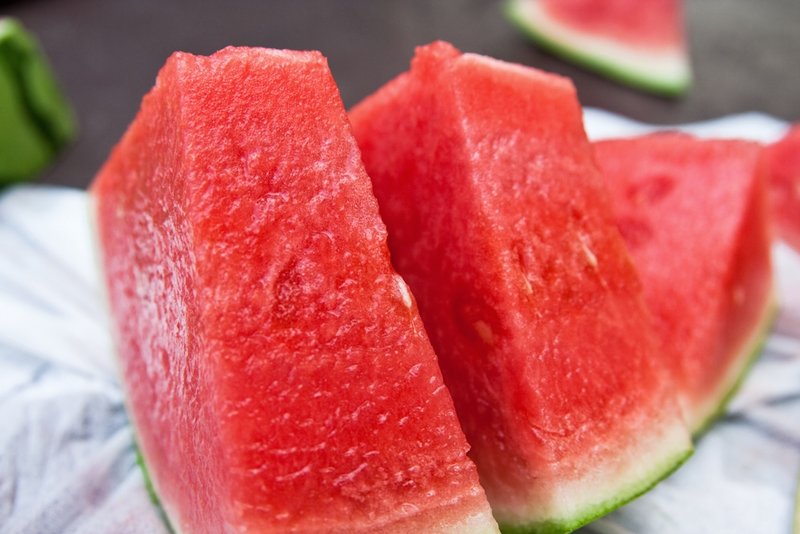Back to August 2017 Newsletter
How Do They Make Seedless Watermelons?

Bob Wildfong
When I was growing up there were games and even children's songs about spitting watermelon seeds. I don't think many kids today would understand those songs, because seedless watermelons have virtually taken over from the traditional seedy varieties.
Of all the oddities to a seed saver, seedless watermelons must be the oddest. Seedless watermelon plants are grown annually from seeds. Think about that. Where do the seeds come from?
The seemingly impossible feat of saving seeds from plants that don't produce seeds is actually not as unnatural as you might expect. No, it isn't genetic engineering. The technique is widely used in conventional horticulture, and has been known for 80 years.
The trick is that they cross two watermelons that are genetically different enough that the resulting hybrid plant is sterile. So the seeds created by the cross are real seeds, but they grow into plants that cannot cannot produce their own seeds or pollen.
In the animal kingdom, the best analogy is the mule. A cross between a horse and a donkey, mules are strong and docile, but they cannot make more mules. By crossing two sets of genes (horse and donkey) that are similar enough to be compatible, but not actually the same, we get an animal whose reproductive parts are sterile.
That's also how seedless grapes are made. Different species of grapes are crossed, to create a "mule" grape, which has no seeds. Seedless grapes are easy to propagate because once you have one plant you can just take cuttings to make multitudes of identical seedless grape plants.
Watermelons are not so easy because you have to produce new hybrid seeds every year, and there is only one species of watermelon to use for the crosses. To get two kinds of watermelon that are nearly, but not quite, genetically compatible, the trick is to change the number of chromosomes in one of them.
Since 1937, plant scientists have been able to double the number of chromosomes in plants by treating them, during cell division, with a chemical called colchicine. Colchicine is a natural extract of the Autumn crocus (genus Colchicum) which has been used as a natural medicine for gout for thousands of years. Plants with doubled chromosomes often have larger leaves and flowers, so colchicine has been widely used to produce ornamentals with larger flowers since the 1940s. For instance, many heirloom lilies were produced using this technique.
Normal watermelons are "diploid", which means they have two copies of each of their chromosomes in each cell (22 chromosomes in all). The cholchicine treatment creates a "tetraploid" watermelon with four copies of each chromosome (44 in each cell). Both diploid and tetraploid watermelons are reproductively stable, so you can propagate them separately and maintain them as true varieties.
Now comes the trick. When a tetraploid (4 chromosome) watermelon flower is pollinated with pollen from an ordinary diploid (2 chromosome) watermelon, the resulting seed will be a "triploid" plant with 3 chromosomes in each cell. Plants with odd numbers of chromosomes are sterile because the chromosomes have to match up in pairs during reproduction. That means triploid plants cannot make pollen or seeds.
So the pollinated tetraploid flower will grow into a watermelon with ordinary looking seeds, and each seed will contain a living baby plant that can grow. But the baby plants inside the seeds will be "mules". When you plant those seeds they will grow into watermelon plants that cannot make their own seeds. Instead you will just see little white spots or gaps where the seeds should have been.
If you plant seedless watermelon seeds, there is one more thing you should know. The fruit cannot form unless the flowers are pollinated, and the seedless plants cannot make pollen. You have to grow some normal watermelons nearby to provide that. The pollen will not fertilize the seeds in the usual way, of course, but it stimulates the seedless flowers to form a fruit.
It's quite a task to create seedless watermelon seeds, but it isn't difficult and it's actually a natural process that occurs in trees and grasses all the time (though naturally seedless annuals die out right away so you never see them). All you would need to do is obtain some tetraploid watermelon seeds, maintain them as a separate variety, and cross them with ordinary watermelons to make seedless seeds. Since seedless watermelons are so popular there is a sizeable industry in the U.S. serving that unending demand, and they keep their tetraploid varieties secret, hidden, and patented. Still, the methods have been used for nearly 80 years so there is probably someone out there with the right seeds that you could try.
**
Bob Wildfong is Seeds of Diversity's executive director.
Photo: Mini Seedless Watermelon, Dulcinea Farms PureHeart by Steven Depolo. CC BY 2.0.
Not yet a member?
An annual membership to Seeds of Diversity gives you access to our seed exchange, seed grow-out programs, and our online news.

We depend on donations to do our work.

Thank you for your support!
